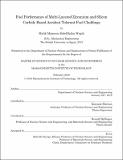Fuel performance of multi-layered zirconium and silicon carbide based Accident Tolerant Fuel claddings
Author(s)
Wagih, Malik Mamoon AbdelHalim
DownloadFull printable version (3.483Mb)
Other Contributors
Massachusetts Institute of Technology. Department of Nuclear Science and Engineering.
Advisor
Koroush Shirvan.
Terms of use
Metadata
Show full item recordAbstract
The Accident Tolerant Fuel (ATF) program is focused on extending the time for fuel failure during postulated severe accidents compared to the standard UO₂-Zr alloy fuel system. This thesis investigates the feasibility of four different cladding concepts, two of which are zirconium-alloy based and two are SiC-based. The Zirconium-alloy based claddings are 1) Zr4-Chromium coated cladding and 2) Zr4-FeCrAl coated cladding with a molybdenum interlayer (Zr4-Mo/FeCrAl). The SiC-based claddings are 3) composite SiC coated with chromium (SiC/SiC-Cr) and 4) Three layered SiC cladding consisting of inner and outer monolith with a composite layer sandwiched in between (mSiC-SiC/SiC-mSiC). The coated claddings were kept to a 50[mu]m of coating thicknesses, deducted from the base layer thicknesses. The claddings were studied, using the multi-physics fuel performance tool MOOSE/BISON, under steady-state PWR operating conditions as well as two transients: power ramp and loss-of-coolant accident (LOCA). The major finding is that the chromium coated concepts proved to be the most promising in both Zr4 and SiC based claddings. The three layered SiC cladding showed a high probability of failure during normal operation and transient conditions, while the Zr4-Mo/FeCrAl cladding showed high plastic strains in the molybdenum layer making its possibilities of survival questionable. On the other hand, the Zr4-Cr and SiC/SiC-Cr concepts showed acceptable plastic strains for the chromium coatings, with the SiC/SiC-Cr being more advantageous during LOCA scenarios. Both concepts warrant further experimental investigation as well as modelling of beyond design-basis accidents.
Description
Thesis: S.M., Massachusetts Institute of Technology, Department of Nuclear Science and Engineering, 2018. This electronic version was submitted by the student author. The certified thesis is available in the Institute Archives and Special Collections. Cataloged from student-submitted PDF version of thesis. Includes bibliographical references (pages 86-91).
Date issued
2018Department
Massachusetts Institute of Technology. Department of Nuclear Science and EngineeringPublisher
Massachusetts Institute of Technology
Keywords
Nuclear Science and Engineering.